250th Station Hospital Unit History
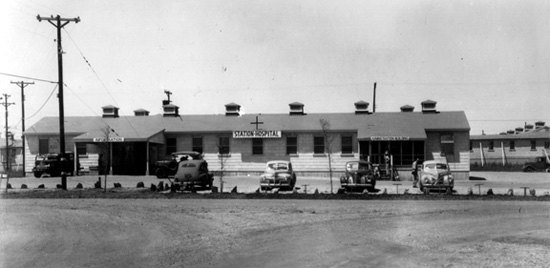
Partial view of the Post Station Hospital, Camp Phillips, Salina, Kansas. Division Camp where the 250th Station Hospital was officially activated 25 February 1943 under command of Lieutenant Colonel Warner F. Bowers, MC, O-312720.
Introduction & Activation:
The 250th Station Hospital was activated at Camp Phillips, Salina, Kansas (Division Camp; total acreage 44,078; troop capacity 1,920 Officers and 36,104 Enlisted Men –ed), on 25 February 1943. It subsequently moved to Camp Kilmer, New Jersey 28 December 1943, and departed for overseas the following day, 29 December 1943. The unit was to serve in the European Theater of Operations, the United Kingdom (9 Jan 44), France (20 May 45), and Germany (14 Jun 45). Germany was the organization’s last overseas station in World War Two.
By Letter dated February 25, 1943, Headquarters Camp Phillips, Office of the Commanding Officer, and General Orders No. 5, and:
In compliance with Letter TAGO, January 5, 1943, AG 320.2 (dated 30 December 1942), OB-I-SP-M, Subject: Constitution and Activation of Medical units in January and February 1943, and as amended by Letter AG 320.2 (dated 18 January 1943), OB-I-SP-M, January 20, 1943, same subject, and Letter AG 320.2 (dated 25 January 1943), OVB-I-SP-M, January 28, 1943, same subject, and Headquarters Seventh Service Command, Services of Supply, February 3, 1943, File SPKPA 320.2 (1943) (O), the following listed units are activated this date, February 25, 1943, at Camp Phillips, Kansas:
249th Station Hospital
250th Station Hospital
By order of Colonel LISTON.
signed D. L. Brock, Captain, Cavalry,
Adjutant

Camp Phillips, Salina, Kansas in 1942-43. View of one of the ‘typical’ buildings housing military personnel. As can be judged from the picture, the sort of billets/quarters were rather austere and of cheap construction, and very difficult to keep warm during winter …
By Letter dated February 27, 1943, Headquarters 250th Station Hospital, Camp Phillips, Salina, Kansas, Hospital Orders No. 1:
1. Activation of the 250th Station Hospital: Pursuant to Instructions contained in War Department Restricted Letter TAG, January 28, 1943, Adjutant General 320.2 (1-25-43), OB-I-SP-M, February 3, 1943, Subject: Constitution and Activation of Medical units in January and February 1943, per Paragraph 1, General Orders # 5, Headquarters Camp Phillips, February 25, 1843, Activation of the 250th Station Hospital is accomplished.
2. Assumption of Command: Pursuant to authority contained in Paragraph 6a, AR 600-20, undersigned hereby assumes command of the organization.
Warner F. BOWERS,
Lt. Colonel, MC,
Commanding
By Letter dated October 21, 1943, Headquarters 250th Station Hospital, Camp Phillips, Kansas, General Order No. 1:
1. Under the provisions of AR 600-20, the undersigned hereby assumes official command of the 250 Station Hospital, Camp Phillips, Kansas.
Arthur E. WHITE,
Colonel, MC,
Commanding
Organization:
Following its activation at Camp Phillips, Salina, Kansas, on 25 February 1943, as a 250-bed Station Hospital, as outlined in T/O 8-560, the organization was composed initially of a cadre of 1 Officer and 25 Enlisted Men who had been transferred from Fort George G. Meade, Baltimore, Maryland (Army Ground Forces Replacement Center; total acreage 18,048; troop capacity 2,019 Officers and 35,131 Enlisted Men –ed), for this specific assignment. The Medical Officer in charge in this incipient stage was Captain Herbert Lakoff, MC, O-1696191, who was superseded in command by Lieutenant Colonel Warner E. Bowers, MC, O-312720, on 27 February 1943.
On 1 August 1943 the 250th Station Hospital and the 249th Station Hospital were merged and activated as a 750-bed Station Hospital, retaining the identifying number of the 250th. On 21 October 1943, Colonel Arthur E. White, MC, O-19328, was assigned to the unit and assumed command.
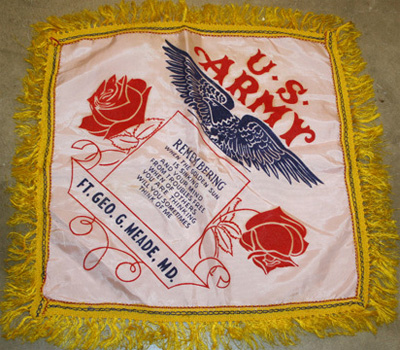
Picture illustrating a ‘Fort George G. Meade’ pillow sham. Such souvenirs could be purchased at the Post PX for forwarding to parents, sweethearts, or relatives by the service personnel stationed at the Army Post.
During the following months of November – December of 1943, Medical Corps Officers, Medical Administrative Corps Officers, Dental Corps Officers, Chaplains, and Sanitary Corps Officers, were continually arriving into the unit bringing it up to full strength in Officer personnel. In November 1943, 50 Nurses (ANC Officers) joined the unit. The basic T/O & E 8-560 dated 22 July 1942 indicated an authorized strength of 40 Officers – 75 Nurses – 1 Warrant Officer – and 392 Enlisted Men. Following civilian personnel were required for the larger installations (750-900 bed capacity –ed), such as 3 Dietitians, 3 Physio-Therapists, and 2 Seamstresses. Vehicles numbered 15 only.
Training:
During the year 1943, the organization was in continuous state of training. Training was started immediately upon activation and was continued until arrival of the 250th Station Hospital at the Port of Embarkation.
Close coordination between the Camp Phillips Plans & Training Officers and the Hospital Plans & Training Officer was maintained at all times and the status of training was continually showing improvement. During October 1943, training was intensified, especially the technical aspect in its final phases. Examinations and tests were held, both practical and theoretical, to determine the exact qualification and training status of the organization’s personnel.

Typical examples of some of the exercises included in ‘general training’ of units bound for overseas operations. At left, personnel negotiating some aspects of the obstacle course. At right, men using nets for ship boarding and debarkation exercises.
During November 1943, all personnel members had completed MTP 8-1, and all technical personnel had, in addition, completed MTP 8-10. Due to lack of time, the 250th did not participate in any stateside maneuvers, but did, however, establish and carry out its own field problems. During September 1943, the 250th Sta Hosp operated for two weeks as a complete tented hospital, receiving and treating numerous patients. In November 1943, the unit again went into bivouac, this time primarily to teach methods of camouflage and the treatment of casualties under complete blackout conditions.
The equipment of the unit was adequate and supplies were on hand with the exception of medical supplies, which were to be procured by the 250th upon its arrival overseas. Transportation means were complete as allowed by T/O & E 8-560 (750-bed Station Hospital). The vehicles did not, however, accompany the organization overseas!
Conservation of material and manpower was carried out theoretically and practically. Classes for conservation and care of equipment were held prior to movement and personnel were taught methods of caring for the unit’s equipment, stressing the importance of such procedures due to the limited supplies which would only be on hand upon arrival at the overseas destination. No special problems were encountered by the unit as a whole, with the exception of reclassification of personnel upon the merger of the 249th and 250th Station Hospitals. This was carried out to a satisfactory completion.

View of Operating Room in action. Medical Officers assisted by Nurses operate on a patient.
While at Camp Phillips, the 250th Station Hospital was billeted in temporary buildings of wood construction. They were inadequate, especially in November and December when temperature was very low. The buildings were of cheap construction and much time was spent by the unit personnel in keeping them in near-livable condition. Although water supply was adequate and potable, there were insufficient outlets. It could be obtained in only three buildings, the mess and two latrines. Laundry was accomplished by the Post Quartermaster and was truly adequate. The organization lived on field rations during its entire training period, which were both satisfactory in quantity and quality. Sewage and waste disposal was handled by Post utilities at Camp Phillips and was satisfactory as well. VD control was supported by monthly lectures, training films, and prophylactic measures. This control worked to such a satisfactory extent that during October – November – December 1943 there was not one case of Venereal Disease in the unit!
Preparation for Overseas Movement:
On 15 December 1943 the 250th Station Hospital left Camp Phillips, Salina, Kansas, for Camp Kilmer, New Jersey, its Staging Area for movement overseas. As this temporary station the balance of the Nurses were assigned to the unit in order to bring it to full strength of 75 ANC Officers. Here too, the unit was completely processed, and upon completion, was then ordered to New York Port of Embarkation, arriving there 28 December 1943. An advance party consisting of Technical Sergeant Emil J. Loetz, Jr., Technician 5th Grade Anthony J. Ricchiuto, and Private Paul H. Marley left for NY P/E to check and prepare the necessary TAT equipment.

View of Physio-Therapy exercises conducted by ‘specialized’ hospital staff and personnel.
On 29 December 1943, the organization departed New York P/E on the British Transport “Samaria”, heading for the high seas and the European Theater of Operations.
Organizational strength of the unit on 31 December 1943 consisted of 40 Officers – 75 Nurses – 1 Warrant Officer – 381 Enlisted Men – 2 Physio-Therapy Aides – 1 Hospital Dietitian – and 3 American Red Cross personnel.
Personnel Roster (31 December 1943):
Officers
Administration
Colonel Arthur E. White, MC, O-19328 (Commanding Officer)
Major Charles A. Wyatt, MC, O-198809 (Hospital Inspector)
Captain Clarence O. Lee, MAC, O-451529 (Adjutant)
Captain Oliver T. Short, MAC, O-1541240 (Detachment Commander)
First Lieutenant Vachel E. Barton, MAC, O-1541114 (Supply Officer)
First Lieutenant Leslie E. Netzen, MAC, O-1535250 (Registrar)
Second Lieutenant Carl L. Carlson, MAC, O-1545146 (Personnel Officer)
Second Lieutenant Charles L. Gavin, MAC, O-1547943 (Asst Supply Officer)
Second Lieutenant Wilber W. Hoare, Jr., MAC, O-1545224 (Asst Detachment Commander)
Second Lieutenant Bernice D. Houston, MAC, O-1544952 (Mess Officer)
Warrant Officer, Junior Grade Stanley G. Beerline, USA, W-2115755 (Asst Registrar)
Surgical Service
Major Josef S. Cope, MC, O-308057 (Chief Surgical Service)
Major Maurice M. Bellerose, MC, O-596422 (Orthopedic Officer)
Captain Charles S. Joss, MC, O-447883 (Ward Officer)
Captain Frank L. Lombardi, MC, O-1692346 (Chief Roentgenological Service)
Captain David L. Rothstein, MC, O-1690278 (EENT Officer)
Captain Lawrence E. Showalter, MC, O-312706 (Ward Officer)
Captain Joseph P. Spano, MC, O-263437 (Ward Officer)
Captain Louis A. Spicola,; MC, O-331887 (Urological Officer)
Captain Michael S. Zeman, MC, O-344807 (Chief EENT Service)

Picture showing some Nurses of the 250th Station Hospital, while staying at Swindon, Wiltshire, United Kingdom, period April 1944.
Medical Service
Major Albert E. Freed, MC, O-381782 (Chief Medical Service)
Major James A. Reid, MC, O-380734 (Officer in charge of Outpatients)
Captain Angelo A. Ciocca, MC, O-1689580 (Ward Officer)
Captain Frederic W. Hall, MC, O-355164 (Ward Officer)
Captain Herbert H. Lakoff, MC, O-1696191 (Ward Officer)
Captain Ernest L. Miller, MC, O-504335 (Ward Officer)
Captain Harold C. Rininger, MC, O-399742 (Ward Officer)
Captain Nathaniel Sandler, MC, O-422107 (Neuro-Psychiatric Officer)
Captain Clifford W. Thomas, MC, O-239600 (Ward Officer)
Captain Charles E. Thorne, MC, O-1684530 (Ward Officer)
First Lieutenant John N. Briggs, MC, O-470358 (Ward Officer)
First Lieutenant Henry S. Pepin, Jr., MC, O-469819 (Ward Officer)
Second Lieutenant Charles F. Hoesel, MAC, O-1544920 (Pharmacy Officer)
Dental Service
Major William B. Irby, DC, O-370375 (Chief Dental Service)
Captain Clifford C. Wood, DC, O-481339 (Dental Officer)
First Lieutenant Byron B. Gross, DC, O-360039 (Dental Officer)
First Lieutenant Justin C. Tolan, DC, O-1765059 (Dental Officer)
Laboratory Service
Captain Joseph M. Krebs, MC, O-368591 (Chief Laboratory Service)
Sanitary Service
First Lieutenant George A. Schlitt, SnC, O-510332 (Sanitary Inspector)
Chaplain Service
First Lieutenant Linus M. Schrems, ChC, O-531579 (Chaplain)
First Lieutenant Aldrich Susseljee, ChC, O-517905 (Chaplain)
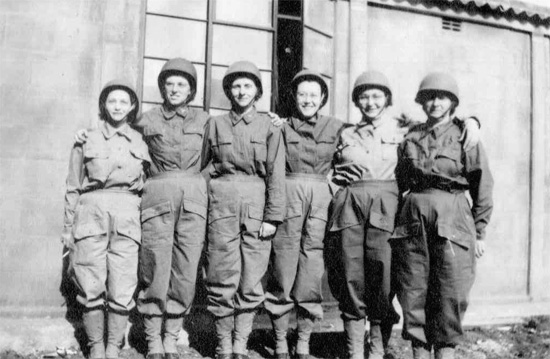
Picture illustrating group of Nurses of the 250th Station Hospital, during their stay at Burford, Wiltshire, United Kingdom. Picture taken some time in May 1944, when on detached service with the 203d General Hospital. Please note all Nurses are wearing HBT fatigues.
Nurses
First Lieutenant Katharine L. Knott, ANC, N-772339 (Principal Chief Nurse)
First Lieutenant Marcella C. O’Meara, ANC, N-731188 (Anesthesia Nurse)
Second Lieutenant Doris M. Allshouse, ANC, N-757415 (Medical Ward Nurse)
Second Lieutenant Genevieve M. Arensdorf, ANC, N-772667 (Chief Nurse Surgical Ward)
Second Lieutenant Jane C. Baker, ANC, N-733607 (Operating Room Nurse)
Second Lieutenant Evangeline V. Bakke, ANC, N-772588 (EENT Ward Nurse)
Second Lieutenant Anna M. Barnas, ANC, N-757443 (Medical Ward Nurse)
Second Lieutenant Martha L. Beltz, ANC, N-772747 (Contagious Disease Ward Nurse)
Second Lieutenant Anna C. Bickler, ANC, N-757329 (Surgical Ward Nurse)
Second Lieutenant Alice R. Bifoss, ANC, N-772427 (Contagious Disease Ward Nurse)
Second Lieutenant Eva Ann S. Bockelman, ANC, N-775858 (Medical Ward Nurse)
Second Lieutenant Mareta B. Bodenschatz, ANC, N-772262 (Medical Ward Nurse)
Second Lieutenant Lillian B. Bodine, ANC, N-757610 (Medical Ward Nurse)
Second Lieutenant Mary P. Bostian, ANC, N-757477 (Medical Ward Nurse)
Second Lieutenant Mary F. Brown, ANC, N-775995 (Mess Nurse)
Second Lieutenant Carol V. Cane, ANC, N-772919 (Chief Nurse Medical Ward)
Second Lieutenant Marion E. Castrodale, ANC, N-772865 (Medical Ward Nurse)
Second Lieutenant Rita A. Davison, ANC, N-730758 (Asst Chief Nurse)
Second Lieutenant Elizabeth I. Day, ANC, N-772866 (Medical Ward Nurse)
Second Lieutenant Irene C. Dembski, ANC, N-772482 (Chief Nurse Medical Ward)
Second Lieutenant Dorothy A. Deposki, ANC, N-772874 (Surgical Ward Nurse)
Second Lieutenant Jean H. Duffy, ANC, N-772920 (Medical Ward Nurse)
Second Lieutenant Frances E. Dunning, ANC, N-757530 (Surgical Ward Nurse)
Second Lieutenant Myrtle L. Dyer, ANC, N-772580 (Medical Ward Nurse)
Second Lieutenant Gwyneth Edge, ANC, N-757455 (Genito-Urinary Ward Nurse)
Second Lieutenant Margaret M. Eggert, ANC, N-731929 (Contagious Disease Ward Nurse)
Second Lieutenant Margaret L. Fieldse, ANC, N-772837 (Medical Ward Nurse)
Second Lieutenant Helen M. Flanagan, ANC, N-757271 (Chief Nurse Medical Ward)
Second Lieutenant Florence Funtowitz, ANC, N-772777 (Orthopedic Ward Nurse)
Second Lieutenant Leona T. Gaska, ANC, N-772741 (Medical Ward Nurse)
Second Lieutenant Shirley C. Gluck, ANC, N-757353 (Central Supply Nurse)
Second Lieutenant Mary A. Hanaka, ANC, N-757213 (Central Supply Nurse)
Second Lieutenant Ann Heiser, ANC, N-772903 (Chief Nurse Operating Room)
Second Lieutenant Eleanor H. Hennessy, ANC, N-772756 (Chief Nurse EENT Ward)
Second Lieutenant Elizabeth Herlihy, ANC, N-757380 (Orthopedic Ward Nurse)
Second Lieutenant Pauline Z. Hinkley, ANC, N-772554 (Chief Nurse Contagious Disease Ward)
Second Lieutenant Mayme W. Hipple, ANC, N-772731 (Chief Nurse Medical Ward)
Second Lieutenant Harriet Hondorp, ANC, N-772680 (Surgical Ward Nurse)
Second Lieutenant Anna P. Jeup, ANC, N-772758 (Contagious Disease Ward Nurse)
Second Lieutenant Camillus R. Justus, ANC, N-772880 (Chief Nurse Orthopedic Ward)
Second Lieutenant Elizabeth S. Kennedy, ANC, N-772189 (Medical Ward Nurse)
Second Lieutenant Ida H. Kim, ANC, N-757534 (Neuro-Psychiatry Ward Nurse)
Second Lieutenant Muriel King, ANC, N-757460 (Medical Ward Nurse)
Second Lieutenant Catherine Kusel, ANC, N-772759 (Surgical Ward Nurse)
Second Lieutenant Barbara M. Lalich, ANC, N-772802 (Medical Ward Nurse)
Second Lieutenant Alice L. Larsen, ANC, N-771676 (Medical Ward Nurse)
Second Lieutenant Annabelle H. Larsen, ANC, N-772813 (Operating Room Nurse)
Second Lieutenant Jane A. Lee, ANC, N-725601 (Chief Nurse Genito-Urinary Ward)
Second Lieutenant Irene A. Losin, ANC, N-757520 (Medical Ward Nurse)
Second Lieutenant Marie L. Lowe, ANC, N-757316 (Medical Ward Nurse)
Second Lieutenant Marian J. Mackenzie, ANC, N-772534 (Medical Ward Nurse)
Second Lieutenant Laura C. Masson, ANC, N-757371 (Neuro-Psychiatry Ward Nurse)
Second Lieutenant Elenor M. Mathison, ANC, N-772904 (Night Supervisor Nurse)
Second Lieutenant Margaret McCormack, ANC, N-757421 (Orthopedic Ward Nurse)
Second Lieutenant Mary M. McGrath, ANC, N-757439 (Neuro-Psychiatry Ward Nurse)
Second Lieutenant Helen M. Meister, ANC, N-757441 (Medical Ward Nurse)
Second Lieutenant Wanda J. Mlynski, ANC, N-772892 (Contagious Disease Ward Nurse)
Second Lieutenant Kathleen A. Nugent, ANC, N-772629 (Surgical Ward Nurse)
Second Lieutenant Eleanor A. Obernuefeman, ANC, N-772887 (Medical Ward Nurse)
Second Lieutenant Faith A. Oldham, ANC, N-757406 (Chief Nurse Surgical Ward)
Second Lieutenant Beatrice O. Patterson, ANC, N-772907 (Medical Ward Nurse)
Second Lieutenant Phyllis J. Perkins, ANC, N-772893 (Chief Nurse Medical Ward)
Second Lieutenant Carolyn J. Rhora, ANC, N-772861 (Medical Ward Nurse)
Second Lieutenant Kathleen L. Robedeaux, ANC, N-772895 (Genito-Urinary Ward Nurse)
Second Lieutenant Alice M. Spencer, ANC, N-772910 (Admission & Disposition Nurse)
Second Lieutenant Marie M. Stevens, ANC, N-757102 (Contagious Disease Ward Nurse)
Second Lieutenant Marjorie C. Sword, ANC, N-757526 (Medical Ward Nurse)
Second Lieutenant Inez L. Terry, ANC, N-772883 (Medical Ward Nurse)
Second Lieutenant Doris M. Villerot, ANC, N-772704 (Operating Room Nurse)
Second Lieutenant Betty J. Walsh, ANC, N-772829 (Surgical Ward Nurse)
Second Lieutenant Gertrude E. Wenger, ANC, N-733814 (Medical Ward Nurse)
Second Lieutenant Dolly Adelaide A. Withers, ANC, N-772898 (Medical Ward Nurse)
Second Lieutenant Jean M. Wyman, ANC, N-757498 (Operating Room Nurse)
Second Lieutenant Helen M. Zalewski, ANC, N-772773 (Operating Room Nurse)
Second Lieutenant Alma V. Zehr, ANC, N-772767 (Chief Nurse Medical Ward)
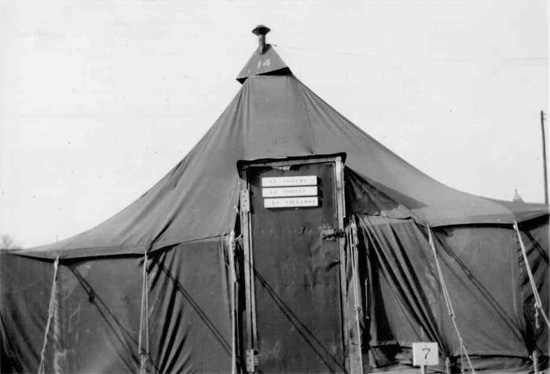
Example of ‘winterized’ Pyramidal Tent. Picture taken in September 1944. As was often done by other medical units, the 250th Station Hospital also started ‘winterizing’ tentage for the coming fall and winter season. Wooden floors, additional doors, and other misecellaneous material was used to make living quarters more comfortable.
Physio-Therapists
Second Lieutenant Florence A. Hurtig, PTA, M-611 (Physio-Therapist)
Second Lieutenant Miriam Ruth L. Rodholm, PTA, M-878 (Physio-Therapist)
Dietitian
Second Lieutenant Dolores L. Heim, HD, R-935 (Head Dietitian)
| Enlisted Men | |
| First Sergeant William E. Shelor, 33048557 | Private First Class Lloyd J. Markillie, 36444937 |
| Master Sergeant Joachim Montaperto, 32311821 | Private First Class Eustacio Martinez, 39037405 |
| Master Sergeant Stewart L. Sprinkle, 33089369 | Private First Class Lloyd A. Mason, 36421086 |
| Technical Sergeant Max Fass, 32371487 | Private First Class Jessie H. McBee, Jr., 34506109 |
| Technical Sergeant Robert K. Hudson, 37211466 | Private First Class John T. McCabe, 32907143 |
| Technical Sergeant Emil J. Loetz, Jr., 33064665 | Private First Class Arthur R. McClain, 36726185 |
| Staff Sergeant Doss H. Burch, Jr., 33048602 | Private First Class William J. McGee, 37656767 |
| Staff Sergeant Laurence H. Catron, 6556980 | Private First Class Henry Mink, Jr., 32723039 |
| Staff Sergeant Ray Haggerty, 32062405 | Private First Class Antonio E. Murrieta, 39855160 |
| Staff Sergeant Thomas A. Harfman, 33140290 | Private First Class Arvin J. Neuhalfen, 36444594 |
| Staff Sergeant Raymond A. McCaffrey, 33149840 | Private First Class John M. Odell, 32743270 |
| Staff Sergeant Angelo Passafaro, 32057643 | Private First Class John W. Ogren, 37142427 |
| Staff Sergeant James W. Viereck, 38032779 | Private First Class Julius Peretz, 32692941 |
| Technician 3d Grade John J. Barr, 7021821 | Private First Class George Popp, 36562438 |
| Technician 3d Grade Steven J. Bronzini, 33249921 | Private First Class Junior C. Price, 37609281 |
| Technician 3d Grade Julian De Neve, 39609771 | Private First Class Thomas F. Rainey, 32721084 |
| Technician 3d Grade Benjamin Frankowski, 35365376 | Private First Class Carter Reid, 34202267 |
| Technician 3d Grade Philip Griminger, 32511928 | Private First Class Lloyd H. Richardson, 37142429 |
| Technician 3d Grade Robert N. Jarvis, 32494287 | Private First Class Richard L. Richardson, 37424663 |
| Technician 3d Grade Clifford D. Johnson, 37325905 | Private First Class Emilio S. Rigores, 32499431 |
| Technician 3d Grade Robert L. Moser, Jr., 6997374 | Private First Class Leroy Shico, 38414932 |
| Technician 3d Grade Weldon J. Patterson, 37289112 | Private First Class Walter E. Stinson, 38306528 |
| Technician 3d Grade Walter V. Reese, 13112651 | Private First Class Harold L. Stoker, 37470874 |
| Technician 3d Grade Clifford D. Roth, 38188940 | Private First Class George A. Strait, 32720909 |
| Technician 3d Grade Victor L. Zwaska, 36248125 | Private First Class Alexander L. Vad, 36562857 |
| Sergeant Donald E. Drake, 37112825 | Private First Class George C. Vogt, 33414707 |
| Sergeant Leo E. French, 37112843 | Private First Class Meridith E. Waggoner, 39407361 |
| Sergeant Roman J. Kupka, 6933338 | Private First Class Elmer H. Waterhouse, 31219641 |
| Sergeant Walter S. Malikowski, 33064623 | Private First Class Lowell D. Wilson, 37470548 |
| Sergeant Oscar L. McClellan, Jr., 34603293 | Private Tommy V. Abernathy, 6936743 |
| Sergeant Ronald R. Shourds, 35586611 | Private Ray K. Abernethy, 34663666 |
| Sergeant Russell B. Wolfe, 33076022 | Private Anastacio Alvarez, 38372428 |
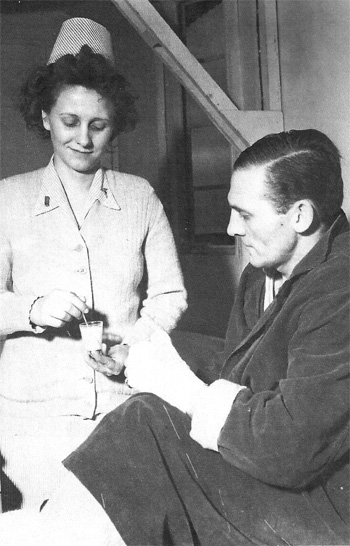
Second Lieutenant Doris M. Villerot, ANC, N-772704, 250th Station Hospital, administers medication to Private First Class William C. Klinger, recovering at this Hospital from wounds received in Belgium (ETO).
| Technician 4th Grade Samuel S. Auerbach, 12126464 | Private Leroy O. Baker, 36465125 |
| Technician 4th Grade Paul B. Blessing, 35020688 | Private Richard E. Bennett, 38468251 |
| Technician 4th Grade Horace E. Brooks, 37499937 | Private Elvin Betts, 38332689 |
| Technician 4th Grade Alvis E. Brown, 38324405 | Private Percy R. Breaux, 38267305 |
| Technician 4th Grade Sidney Buckwald, 12193594 | Private Douglas D. Brown, 38475856 |
| Technician 4th Grade Joseph E. Buhovecky, 13012440 | Private Johnnie M. Brown 39685332 |
| Technician 4th Grade Homer C. Chapman, 34820710 | Private McMannus Broncho, 39908013 |
| Technician 4th Grade William J. Cross, 39692941 | Private Alex Bruhowski, 36562206 |
| Technician 4th Grade William A. DeFilippis, 32493114 | Private Russell R. Bruce, 36748445 |
| Technician 4th Grade Frank J. Federici, 32721147 | Private José Cantu, Jr., 38457153 |
| Technician 4th Grade Robert W. Fitzgerald, 32699829 | Private Dante Carucci, 36749515 |
| Technician 4th Grade Gerald Frank, 32513407 | Private Clarence S. Casey, 38427685 |
| Technician 4th Grade Bernard J. Guidas, 33398275 | Private Alejandro R. Casillas, 39859380 |
| Technician 4th Grade Hoe G. Helmuth, 35343505 | Private Rudy A. Cordero, 39555328 |
| Technician 4th Grade Preston R. Hurlburt, 37378824 | Private Benjamin Costa, 33369721 |
| Technician 4th Grade Roy T. Hykes, 33000431 | Private Delmer D. Cox, 39695982 |
| Technician 4th Grade George D. Jackson, 38464174 | Private Raymond M. Crowley, 32908647 |
| Technician 4th Grade William R. Janulin, 32596998 | Private Charles Cruz, 38366210 |
| Technician 4th Grade John F. Kolek, 36286118 | Private Chester C. Cudnik, 36000188 |
| Technician 4th Grade Elmer E. Kolodzinski, 36613318 | Private Patrick J. Daly, 32734962 |
| Technician 4th Grade Russell C. Landen, 34664004 | Private Vincent J. Del Guidice, 32742608 |
| Technician 4th Grade Manring V. Malmstrom, 39907757 | Private Bernard R. Depkin, 33018529 |
| Technician 4th Grade William L. McNair, 39201598 | Private Mack Derreberry, Jr., 35591180 |
| Technician 4th Grade Howard W. Morris, 32742974 | Private William H. Dixon, 34663986 |
| Technician 4th Grade Wallace S. Nichols, 32488400 | Private Alvin H. Donoho, 34329650 |
| Technician 4th Grade John C. Oliver, Jr., 37454719 | Private Dave Dotson, 35652851 |
| Technician 4th Grade Theodore Parker, 35615513 | Private Richard A. Esquivel, 38456679 |
| Technician 4th Grade Barton J. Plunkett, 39325567 | Private Fermin R. Estrada, 38358617 |
| Technician 4th Grade Peter Prymak, 31258872 | Private Chester H. Fawcett, 38463521 |
| Technician 4th Grade Albert G. Russell, 33150211 | Private Harold L. Fisher, 39328961 |
| Technician 4th Grade Gilberto Salinas, 38366231 | Private Robert W. Flodin, 13142891 |
| Technician 4th Grade George Smith, 4439705 | Private Samuel R. Fogarty, 38434547 |
| Technician 4th Grade George E. Van Ronzelen, 37373297 | Private Stanley J. Furford, 39203822 |
| Technician 4th Grade Hubert R. Wendler, 37381495 | Private Manuel L. Garay, 38428468 |
| Technician 4th Grade Lester S. Williams, 34506664 | Private Kenneth W. Gibson, 38402845 |
| Technician 4th Grade Alex J. Yannone, Jr., 32743170 | Private William W. Gibson, 37245354 |
| Technician 4th Grade Clemence P. Zuchowski, 33359882 | Private Stephen G. Gochis, 12220330 |
| Corporal James F. Dugan, 33341025 | Private Bruno S. Goclan, 37393729 |
| Corporal Charles F. Foss, 32723086 | Private Manuel G. Gomez, 39288459 |
| Corporal Amos F/ Hemmerlein, 35724526 | Private Frank T. Gori, 39127279 |
| Corporal Charles E. Kisler, 37331844 | Private Herman E. Gray, 34631426 |
| Corporal Alan R. Libby, 39325581 | Private William H. Halstead, Jr., 36568379 |
| Corporal Clyde M. Mellberg, 36421119 | Private William E. Hammond, 17005618 |
| Corporal Frank A. Pacific, 31248084 | Private Noel Hanson, 38397736 |
| Corporal Bruce A. Robinson, 35387165 | Private Delmar R. Harmon, 38212629 |
| Corporal Melvin Rosen, 37413016 | Private Sigmund Haarburger, 32899296 |
| Corporal Richard W. Wearne, 32743239 | Private Jack D. Hayes, 39412780 |
| Corporal Maurice Zivin, 36382629 | Private Harry E. Hemphill, 34823605 |
| Technician 5th Grade Willie G. Ashmore, 37380619 | Private Benjamin C. Henritzy, 33625214 |
| Technician 5th Grade Andreas J. Aumer, 37412960 | Private Santos G. Herrera, 38434725 |
| Technician 5th Grade Robert A. Bailey, 32653960 | Private John W. Hill, 33650140 |
| Technician 5th Grade Stefen Bandrowski, 32717916 | Private Hadnal C. Home, 39122150 |
| Technician 5th Grade Charles G. Bennett, 34769318 | Private Felix P. Hopcus, 32932177 |
| Technician 5th Grade Ransom H. Boltwood, 37334631 | Private Sol Horwitz, 36368200 |
| Technician 5th Grade Albert M. Boyle, 31280017 | Private Edward C. Hunt, 32921348 |
| Technician 5th Grade Horace M. Brown, 34653896 | Private Donald Hyde, 36808157 |
| Technician 5th Grade Joseph C. Cantelmo, 32605784 | Private Fred B. Jenkins, 39203103 |
| Technician 5th Grade James E. Carter, 34769923 | Private Kenneth A. Johnson, 36568441 |
| Technician 5th Grade Harold H. Cauble, 34773803 | Private Frank Johnston, Jr., 39696026 |
| Technician 5th Grade Phillip V. Cavallo, 32949709 | Private William A. Jones, 32949886 |
| Technician 5th Grade Carl A. Chimenti, 33679797 | Private Carlos M. Dijols, 32907814 |
| Technician 5th Grade Lawrence E. Chipman, 37658401 | Private John F. Klecha, 13005604 |

Copy of Football Game Program organized by the 250th Station Hospital. The game took place on Thanksgiving Day, 23 November 1944, Grimsditch, Hampshire, United Kingdom.
| Technician 5th Grade Manuel R. Chorro, 38426836 | Private William R. Knightly, 31284267 |
| Technician 5th Grade Norman J. Cooper, 31280279 | Private Donald A. Kolonowski, 36450509 |
| Technician 5th Grade Salvatore A. Del Belso, 32743179 | Private Stephen Kurtiak, 35604373 |
| Technician 5th Grade Gilberto A. De Los Santos, 38365219 | Private Boleslaus J. Kuzdzal, 36850688 |
| Technician 5th Grade Chester M. Domanowski, 35019429 | Private George E. La Roque, 36562290 |
| Technician 5th Grade Eugene H. Douglass, 38022478 | Private Ronald J. La Freniere, 39412750 |
| Technician 5th Grade Robert E. Drayer, 33624971 | Private Vincent P. La Banco, 32716626 |
| Technician 5th Grade John J. Farrell, Jr., 39120868 | Private Orville B. Lamb, 37452304 |
| Technician 5th Grade Harry C. Feldhausen, 37142570 | Private Joseph F. Lang, 33687113 |
| Technician 5th Grade Howard R. Follis, 31283392 | Private Ray C. Larson, 37039062 |
| Technician 5th Grade Marcello Garcia, 38365527 | Private Robert E. Lavaway, 31283273 |
| Technician 5th Grade Cayetano O. Garcia, 39278348 | Private Anselmo A. Leal, 38454373 |
| Technician 5th Grade Louis George, 36227524 | Private Albert L. Lee, 38402684 |
| Technician 5th Grade Gene E. Gereke, 37220039 | Private George S. Levielle, Jr., 31265972 |
| Technician 5th Grade Arnold J. Gonnering, 37160732 | Private Thomas Lucibello, 31280035 |
| Technician 5th Grade Oscar G. Harris, 34663502 | Private Alex J. Majewski, 36100372 |
| Technician 5th Grade Floyd Hipps, Jr., 36568037 | Private Melvin J. Mallard, 33687094 |
| Technician 5th Grade Emil J. Jagodowski, 31346831 | Private Herman C. Malone, 36444797 |
| Technician 5th Grade Don J. Jarsma, 36151346 | Private Paul H. Marley, 37337243 |
| Technician 5th Grade Ralph K. Kinne, 36801779 | Private Anthony Marszalek, 31281609 |
| Technician 5th Grade Charles R. Kirst, 36215755 | Private James E. Martin, 34506797 |
| Technician 5th Grade Alfred H. Kunkel, 36568393 | Private Winford H. Martin, 38463595 |
| Technician 5th Grade Clifford E. Lamb, 36636699 | Private George Margiotta, 36169030 |
| Technician 5th Grade Wellington C. Lawrence, 36468035 | Private Willis McCartney, 13011029 |
| Technician 5th Grade Roger W. Lucas, 36801950 | Private Warren R. McCauley, 35598684 |
| Technician 5th Grade Jesus S. Maldonado, 39277560 | Private Edward J. McConnell, 39463445 |
| Technician 5th Grade Albert L. Martin, 33414706 | Private Arthur W. McFarling, 39463474 |
| Technician 5th Grade Tsee W. Mark, 39198735 | Private Edward P. McGowan, 31064753 |
| Technician 5th Grade John C. McCullough, 36568168 | Private Wilbur A. Mead, 36420301 |
| Technician 5th Grade William R. Moore, 39120212 | Private Benjamin M. Miller, 39288415 |
| Technician 5th Grade Wayne H. Morris, 38446224 | Private Harry A. Miller, 32832323 |
| Technician 5th Grade Alfred J. Muller, 32681449 | Private Milton A. Miller, 39329519 |
| Technician 5th Grade Anton W. Nanni, 36444588 | Private Harry C. Mitchell, 36420325 |
| Technician 5th Grade William A. Neuenschwander, 36509776 | Private William D. Montfort, 35696403 |
| Technician 5th Grade Thomas F. O’Reilly, Jr., 33419671 | Private Guillermo C. Morales, 38456642 |
| Technician 5th Grade Edwin L. Ousse, 38267343 | Private Edward J. Morin, 31283339 |
| Technician 5th Grade Dwight E. Palmer, 34603068 | Private Otto E. Mortensen, 36420400 |
| Technician 5th Grade Basilio J. Pomposini, 13021636 | Private Albert H. Myers, 34378868 |
| Technician 5th Grade Arthur A. Quinn, 32793709 | Private Max M. Nahoum, 36571822 |
| Technician 5th Grade Robert R. Rakovan, 36562352 | Private Eduardo J. Navarro, 38365777 |
| Technician Anthony J. Riucchiuto, 12219253 | Private Carl O. Olson, 37291307 |
| Technician 5th Grade Raymundo R. Rivas, 36365270 | Private Edward J. Panichelle, 13010989 |
| Technician 5th Grade Corwin A. Robert, Jr., 34150486 | Private Frederick S. Parker, 36562247 |
| Technician 5th Grade Robert E. Rucker, 34282937 | Private Charles J. Paul, Jr., 32907704 |
| Technician 5th Grade Colin G. Scott, 39325058 | Private Arthur L. Pelletier, 31269746 |
| Technician 5th Grade George Sikora, 35437163 | Private George P. Pelletier, 31219617 |
| Technician 5th Grade Anthony J. Slantz, 33414723 | Private Mitchell E. Penn, 31246719 |
| Technician 5th Grade Leonard J. Smith, 36564882 | Private Lloyd W. Peterson, 35599663 |
| Technician 5th Grade Vincent R. Steffens, 37417236 | Private Robert R. Pezzini, 31355668 |
| Technician 5th Grade Frank E. Stiller, 34603094 | Private Arthur E. Pickett, 36568211 |
| Technician 5th Grade Roy G. Tognola, 39120889 | Private Edward J. Poniatowski, 36566884 |
| Technician 5th Grade James P. Turner, 35367435 | Private Bonaventure T. Porpora, 32906374 |
| Technician 5th Grade Frank Vella, 39116541 | Private Elbert G. Powers, 36575816 |
| Technician 5th Grade Jack O. Wood, 38402904 | Private Glen W. Price, 39412776 |
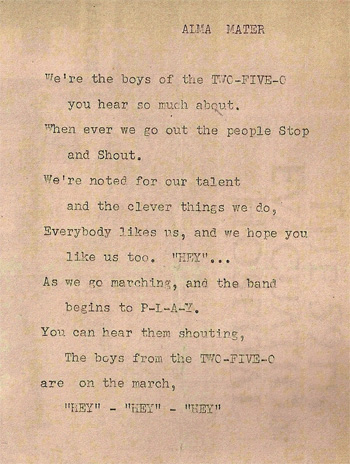
“Alma Mater”, short song created by the personnel of the 250th Station Hospital.
| Private First Class Melvin C. Anderson, 39125493 | Private Howard R. Price, 34663447 |
| Private First Class Wallace R. Atkins, 32718861 | Private Siegfried E. Richards, 32951934 |
| Private First Class George R. Beckwith, 31218029 | Private Isaac N. Rickman, 34715126 |
| Private First Class Samuel E. Bodily, 34506995 | Private Halsey C. Rifenburg, 32743274 |
| Private First Class Vern R. Bolinger, 37499941 | Private Everett M. Roberson, 38475759 |
| Private First Class George F. Bucci, 32619804 | Private Basilio M. Rodriguez, 38456564 |
| Private First Class Kenneth E. Bufton, 36562750 | Private Lee H. Rodriguez, 38456880 |
| Private First Class Edward D. Burkhart, 34773853 | Private Leonard S. Rollo, 33605759 |
| Private First Class Eustasio D. Castillo, 38372164 | Private John H. Roth, 36421769 |
| Private First Class Hubert R. Cheek, 14000008 | Private John E. Rowan, 31036746 |
| Private First Class Everett A. Clark, 20759070 | Private Kenneth J. Rush, 31280073 |
| Private First Class Dale E. Cozad, 37440980 | Private Edward J. Russell, 32746482 |
| Private First Class Douglas C. Davis, 37656471 | Private Alfonso Santacroce, 33686238 |
| Private First Class Edmund J. Deshan, 36568425 | Private Jesse Segovia, 38431672 |
| Private First Class Malcolm L. Dillon, 33650507 | Private John T. Sheehan, 31355162 |
| Private First Class Archable A. Dockery, 38397746 | Private Joseph Shymanski, 32608423 |
| Private First Class John H. Drewe, 36560167 | Private Lahmon Sims, 38419016 |
| Private First Class Stephan Dudzinski, 36532526 | Private Rudolph T. Smith, 34663504 |
| Private First Class Joseph W. Dunn, 20726898 | Private Harry H. Spangler, 33049689 |
| Private First Class Robert G. Duval, 34783558 | Private Willie C. Stamey, 34499524 |
| Private First Class William C. Edwards, 34769867 | Private Glen C. Stewart, 36371832 |
| Private First Class Junior F. Elder, 20759077 | Private Robert B. Stewart, 34345361 |
| Private First Class Joe E. Espinosa, 38365814 | Private Joe L. Stratton, 34591944 |
| Private First Class Murray Friedlander, 32793231 | Private Francisco S. Sylvia, 31356679 |
| Private First Class Ernest A. Gerkman, 39328964 | Private Jesse M. Taylor, 38343150 |
| Private First Class Tony Giovinco, 32903307 | Private Manuel D. Theodore, 31356690 |
| Private First Class Martin H. Gleason, 31334026 | Private Milo J. Thorne, 36421075 |
| Private First Class Russell C. Goode, 37103971 | Private Arthur J. Touranteau, 36562137 |
| Private First Class Troy E. Hadaway, 34473823 | Private Robert L. Trulove, 20759073 |
| Private First Class Robert W. Hauer, 32659120 | Private Sam Tulimero, Jr., 32906110 |
| Private First Class Harold F. Heim, 37660304 | Private Jack D. Van Buren, 39127333 |
| Private First Class Alphonso Hennessey, 31270387 | Private Roland E. Van Sickle, 35588631 |
| Private First Class Nathaniel M. Hilliard, 34603062 | Private Wayne L. Ward, 38468325 |
| Private First Class Orvelle C. Hintz, 36255086 | Private Oval D. Weaver, 39277927 |
| Private First Class Walter J. Hublard, 31 280446 | Private George H. Webber, 36562291 |
| Private First Class Gilbert B. Johnson, 38396208 | Private Murray Williams, 38474982 |
| Private First Class Max Kaplan, 32904547 | Private Henry N. Wilson, 34603013 |
| Private First Class Donald E. Keefe, 31 219635 | Private Eugene C. Wolff, 37614422 |
| Private First Class James L. Kelley, 34447046 | Private Benjamin F. Woods, 38468383 |
| Private First Class Raymond T. Lewis, 37439978 | Private William P. Younker, 33625203 |
| Private First Class Eugene D. Magee, 36562756 | Private Thomas W. Young, 32717872 |
| Private First Class John A. Mallicote, 38413131 | Private Harry C. Zack, 32717630 |
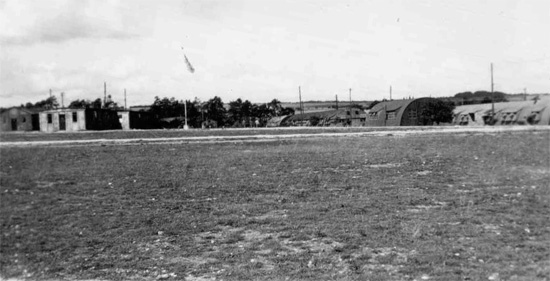
Partial view of Headquarters, 250th Station Hospital, located at Grimsditch, Hampshire, United Kingdom. Picture taken in January 1945.
United Kingdom:
On 1 January 1944, the 250th Station Hospital under command of Colonel A. E. White, was on board British Transport HMT “Samaria”, enroute to the European Theater of Operations. The next seven days passed uneventfully and the vessel docked at Liverpool, England, on 8 January 1944. On the evening of 9 January, the personnel debarked in two separate groups and entrained for Cheltenham, Gloucestershire. From Cheltenham they were further transported by motor convoy to the hospital site at Ullenwood, 2½ miles south of Cheltenham, Gloucestershire, arriving there early in the morning of 10 January 1944, where they were met by the advance detachment of the unit.
A Detachment of Officers, Nurses, and Enlisted Men from the 32d General Hospital was stationed at Ullenwood and had received and installed the supplies and equipment for operation of the Hospital. Due to their excellent work and wholehearted cooperation, the 250th was able to take over operation of the Hospital unit on 18 January 1944, and on that date the 32d Gen Hosp Detachment departed for their parent unit.
On the day the 250th Station Hospital assumed full operations at Ullenwood, there were approximately two hundred and fifty (250) patients in the different wards. These patients were all from nearby units and from Headquarters, Services of Supply, ETOUSA, located near Cheltenham, Gloucestershire, and about five miles distant from the Hospital.
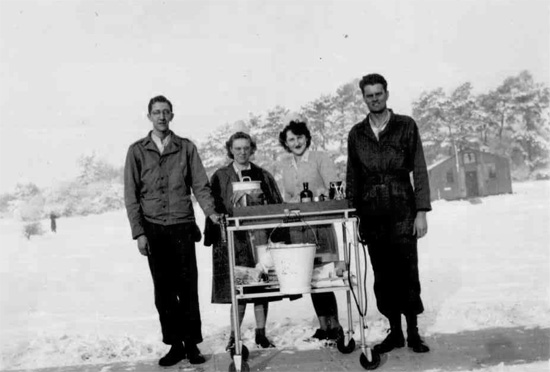
Winter at the 250th Station Hospital. Dressing rounds between the different hospital wards. Picture taken January-February 1945 during the unit’s stay at Grimsditch, Hampshire, United Kingdom.
There was a certain non-effective rate of the unit mainly due to overcrowding on the sea voyage and partly to acclimatization from the Middle West dry air to the damp and cold English weather. Many patients were afflicted with either naso-pharyngitis or mumps. As a matter of fact, a mild epidemic of mumps that had been prevalent in the Cheltenham area was then on the decline. The hospital buildings were of a uniform plan and setup and constructed of hollow tile, roofed with asbestos cement sheets. Adequate space was available for all wards, clinics, and laboratories. The quarters reserved for Officers, Nurses, and the Detachment were all of plaster board covered with tar paper and had asbestos cement roofs. The capacity for the Officers’ huts was ten (10), the Nurses’ huts was six (6), and the Detachment’s huts was twelve (12). Quarters were cold, damp, and not adequately heated by small coke-burning grateless stoves. All latrines, showers, and ablution areas, were also inadequately heated, however, there was plenty of hot water available at all times.
When the 250th Sta Hosp arrived at Ullenwood, the channels of command were three: XVII District Headquarters, near Oxford, Oxfordshire; to Southern Base Section Headquarters, near Salisbury, Wiltshire; and to Services of Supply Headquarters, at Cheltenham, Gloucestershire, United Kingdom. On 23 February 1944, the hospital installations at Ullenwood were exempted from Base Section control, and brought under jurisdiction, including Military Police control of Headquarters Command, Services of Supply, European Theater of Operations.
During their time at Ullenwood (south of Cheltenham –ed), the unit was ironing out those thousand and one little details of hospital operation that could not be solved until it was actually functioning. The services were becoming more coordinated and the Hospital was beginning to run very smoothly and with a minimum of administrative effort.
On 15 April 1944, an advance detachment from the 62d General Hospital arrived and preparations were made for the 250th Station Hospital to move out. Two advance parties left the same day for the new station. One party consisted of Nurses who were sent on DS with the “Nurses Provisional Battalion” at Swindon, Wiltshire, and the other comprised Officers and EM who were detached to Pinkney Park, near Sherston, also in Wiltshire (the latter was only ½-hour drive from Swindon –ed). By 20 April 1944, the entire organization had moved out with all the Nurses going to Swindon, under command of Major Charles A. Wyatt, MC, O-198809 and Captain Frederic W. Hall, MC, O-355164, and the rest of the personnel going to Pinkney Park.
At Pinkney Park, contrary to what was expected, the 250th did not function as a hospital, but instead went into training. Classes and lectures were held in the mornings and physical conditioning in the evenings. The quarters were canvas tents with dirt (wood) floors and no heat. Six (6) Enlisted Men were housed per tent and four (4) Officers per tent. While at this station, a sudden outbreak of food poisoning occurred. Sunday evening, 23 April, eighty two (82) Enlisted Men suddenly became extremely ill, twenty three (23) of whom were admitted to US Army Hospitals. Twenty one (21) were evacuated by ambulances to the 217th Station Hospital at Swindon, Wiltshire, and the other two (2) who became ill while on pass, were taken to the 160th Station Hospital near Bath, Wiltshire.The next morning most men had recovered and by 25 April 1944, all recovered. An effort was made to try and find the cause for the outbreak. It was thought to have been caused by rice pudding, but no positive proof of this was available.

Some of the Officers of the 250th Station Hospital at Grimsditch, Hampshire, United Kingdom. From L to R: Major Charles A. Wyatt, MC, O-198809; Captain Clifford W. Thomas, MC, O-239600; Captain Clarence O. Lee, MAC, O-451529; and Major Josef S. Cope, MC, O-308057.
On 28 April 1944, the Nurses moved from Swindon, to the 203d General Hospital, located near Burford, Wiltshire, for a month of intensive training, both in classroom and in the field. During the period that the Officers and Enlisted Men were at Pinkney Park, many of them were sent on DS as surgeons, dispensary teams, and cooks, to the various Channel ports in view of the huge preparations for D-Day, the Invasion of France. On 9 May, the remainder of the 250th moved to Grimsdyke, Hampshire, near Salisbury, Wiltshire, to take over a bivouac area that was in the process of being converted into a hospital plant. Two (2) Engineer Battalions and one (1) Ordnance Repair Unit were occupying the buildings and tents when the 250th Sta Hosp moved in, and because of this situation, the unit was forced to set up temporary quarters under tentage. The camp was in an extremely poor condition to be converted into a functioning hospital. The buildings were run down and badly in need of repairs with windows and doors torn off, walls, floors, windows, and ceilings very dirty. The mess halls were in exceptionally bad condition, with grease spatters all over the place and smells of decomposed protein and grease traps which had apparently not been cleaned for months! There were two areas near the mess halls where garbage had been thrown out over a long period of time, and the place was overrun by rats. Due to insufficient civilian contractors it was felt that the unit would certainly have to assist in the conversion in order to complete it for early occupation of patients. Officers and Enlisted personnel were thus immediately organized into groups to aid in adapting and completing the bivouac into a full-fledged hospital plant. Each group was given a definite assignment to perform, such as: road and sidewalk construction, building repairs and paintings, miscellaneous construction, installation of telephone and electric wiring, camp and general police, and construction of bases for tent quarters for all personnel. It was however soon found out that adequate transportation for moving materials was not available. The groups were then split into two shifts, one working from 0400 to 1300 hours, and the other working from 1300 to 2200 hours.
On 27 May, the ANC Officers who had been training at Burford, Wiltshire (adjacent to the Salisbury and Southampton Canal –ed), rejoined the unit at Grimsdyke (also called Grimsditch –ed). They were able to move into their permanent quarters, tents with cement floors, built-in doors and shelves, and a pot-bellied stove. Following setup the Nurses were then assigned to the different wards, clinics, operating theater and laboratory for the purpose of thoroughly cleaning, painting, and finally unpacking and installing supplies and equipment in there. Supplies were all from American sources and very much appreciated by staff and personnel who had to work with them. The next two weeks were extremely busy ones for everyone, with all the hospital buildings having to be completely equipped, many sidewalks yet to be laid, and twenty one concrete bases for war expansion of tents to be made. All was nevertheless accomplished by the required date of 10 June 1944, and on 11 June 1944 the installation was designated US Army Hospital Plant No. 4125, and officially opened to receive patients. The first patients arrived on 16 June 1944. More tents were procured to install on the concrete bases and were adequately equipped with metal beds, bedding linen, stands and stoves. By 13 July 1944, all expansion had been completed and the Plant now had a capacity of one thousand and sixty five (1065) patients. However, some construction work still went on with many more walks being constructed, and a large assembly tent with cement block floor put up for patient recreation purposes.
On 14 July 1944,Colonel Arthur E. White, previously Commanding Officer, was transferred to the 62d General Hospital, and Lieutenant Colonel Frederic E. Cressman, MC, O-19635, joined the unit and assumed command of the 250th Station Hospital.
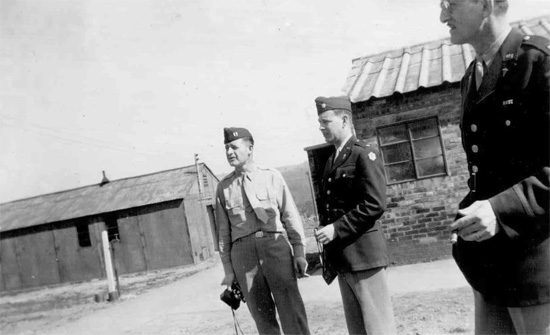
Other Officers of the 250th Station Hospital. From L to R: Captain Lawrence E. Showalter, MC, O-312706; Major Josef S. Cope, MC, O-308057; and Captain Charles E. Thorne, MC, O-1684530.
On 15 August the 250th was selected to receive convalescent patients who were not yet ready for return to duty or for transfer to a Rehabilitation or Reconditioning Center. These patients were limited to those who had already undergone definitive treatment and who would not require evacuation to the ZI. Consequently, three (3) blocks of four (4) wards each were designated as rehabilitation blocks and all Class “A” patients were sent there. In these blocks, the regular hospital beds were removed and double-deck beds installed in order to provide more room and to reach the atmosphere more approximate to that of barracks life. One ward on each of the three blocks was designated a dayroom and was equipped with comfortable chairs, writing tables, radios, books, and games. The walls were painted and decorated by the patients themselves in such a manner as to remind them of clubs at home. The number of patients in the Hospital gradually increased until on 16 August, a high of nine hundred and forty four (944) was reached. The greater percentage were convalescent cases.
On 28 August 1944, Lieutenant Colonel Frederic E. Cressman, Commanding Officer, was placed on TD at the 6810th Hospital Center. On the same day, Major Charles A. Wyatt, MC, O-198809, assumed command and under his leadership, the construction of extra sidewalks and plant improvements as well as care of the patients continued.
On 1 January 1945, the 250th Sta Hosp was functioning at APO # 519 under command of Lieutenant Colonel Albert G. Engelbach, MC, O-173715. The hospital census at that time was 1018. Of these, 315 were occupying beds in the tented expansion. The balance were established in MOW (Ministry Of Works –ed) plasterboard huts of sixteen (16) beds each. The empty beds available, although scattered, were ready for reception of additional patients. Between 1 January 1945 – 8 May 1945, a total of 2256 patients were admitted. They were distributed as follows: 120 came from units stationed in the United Kingdom; 1628 were transferred from other medical units in the United Kingdom; and 508 were admitted directly from continental hospitals.
Of the admissions, 153 were psychiatric cases; 6 organic neurological conditions; 675 other diseases (including trenchfoot and frostbite); 429 non-battle injuries; and 993 battle casualties. Between January and February 1945 the patient census continued over 960, of which 35% were bed patients. From 1 March 1945 – 28 April 1945, when admissions were stopped, the census gradually dropped. As of midnight, 28 April, there were 544 patients left. Upon orders received from the Commanding officer, 802d Hospital Center, APO # 314, all of these patients (with the exception of one), were transferred to other hospitals or to the Zone of Interior within a period of five (5) days.
On 8 May 1945, the 250th Station Hospital was still operating at Grimsdyke, Hampshire, near Salisbury, Wiltshire, England, when orders were received to transfer all patients to other hospitals either in the United Kingdom or to the Zone of Interior. The unit subsequently received Alert Orders for a forthcoming change of station, involving a possible transfer to the Continent.

Château at Mesnières-en-Bray, where the Nurses of the 250th Station Hospital where temporarily quartered after landing at Le Havre, France, 21 May 1945.
The physical layout of the 250th Sta Hosp was such that it was necessary, in the care of patients, to carry water, bedpans, urinals, trays, medications and dressings outdoors from the duty and sluice rooms to the different wards, a distance from 30 to 90 feet, which required additional work and time. In spite of this, the ward attendants and Nurses gave the patients their highest care. Eight (8) patients had bed sores. In all cases, these were present on patients who had been transferred from other hospitals and were found on removal of casts. Fortunately, the sores healed before the patients were further transferred or discharged for return to duty. No new bed sores developed at the Hospital.
One (1) death occurred at 1205 hours, 19 March 1945. The victim was Private First Class Earl R. Markey, 33903136. The direct cause of death was pulmonary embolism (nature of injuries: penetrating shell wounds in both legs, traumatic amputation of right leg, complications right thigh). Death occurred with an hour and a half after a change of dressing on the amputation stump.
Medical Service
The following cases were admitted directly to the different medical wards:
Trenchfoot & Frostbite > 487
Neuro-Psychiatric > 256
Gastro-Intestinal > 63
Skin Infections > 50
Naso-Pharyngitis > 45
Hepatitis > 42
Arthritis > 34
Tonsillitis > 14
Cardiac Problems > 14
Pneumonia > 12
Kidney Pathology > 12
Bronchitis > 11
Venereal Diseases > 10
Asthma > 9
Malaria > 4
Miscellaneous > 95

1945, USO Show held at Regensburg, Germany, near the location of the 250th Station Hospital.
Surgical Service
During the first four (4) months of 1945, the Surgical Service admitted 1395 patients, of which 91% were battle casualties, and which received emergency treatment. The greatest burden was borne by the Orthopedic Section which received a total of 576 patients, representing 41% of the total. The total gradually went up until it reached almost 70% of all admissions to the Surgical Service. The number of operations consisted of:
Number of Consultations > 1395
Minor Operations > 839
Plasters Operations > 570
Number of Refractions > 358
Glasses Ordered > 140
Major Operations > 118
Diagnostic Procedures > 103
Preparation for Change of Station:
On 20 May 1945, the organization departed from Grimsdyke, Hampshire, enroute to Southampton Port where it would board for the Channel crossing. After successfully embarking on the USAT “Marine Wolf” and leaving with the evening tide, the 250th started its Channel crossing the same day.
The Hospital arrived at Le Havre, France, 21 May 1945, and following debarkation, all male personnel were transported to “Camp Twenty Grand” (one of the many Cigarette camps –ed) near Duclair, and all female personnel were sent to an “Army Nurse Corps Staging Area” at Mesnières-en-Bray, near Neufchâtel-en-Bray, France, for quarters and administration during a short period. On 25 May 1945, the main body of the unit began movement by rail to the Maginot-Niel Medical Staging Area (also designated “Eagle Main Staging Area Verdun” –ed), Verdun, France, reaching destination on 27 May 1945. The 250th was now part of the Continental Base Section, APO # 225, United States Army.
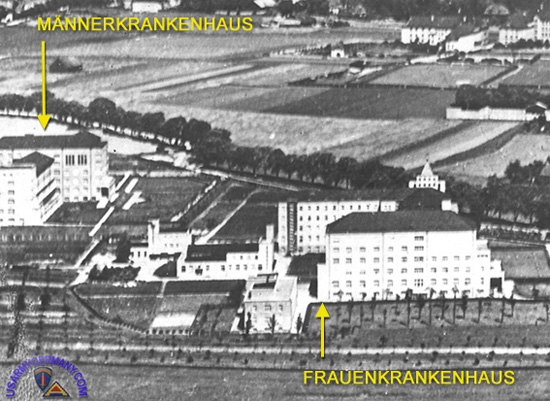
July 1945. General view of the 250th Station Hospital operating on the premises of the former “Männerkrankenhaus” and “Frauenkrankenhaus” in Regensburg, Bavaria, Germany. The installations consisting of two modern hospital buildings and annexes were taken over by the 101st Evacuation Hospital, relieved by the 250th Sta Hosp 20 June 1945. Photo courtesy USAREUR.
On 5 June 1945, a unit detail entrucked for Liège, Belgium, to draw medical supplies and equipment required for the organization’s next mission.
Germany:
On 11 June 1945, the main unit body left Verdun, France, by rail for its new station at Regensburg, Germany, where it arrived 14 June 1945. Upon arrival the 250th found out that they had been assigned the “Männerkrankenhaus” and the “Frauenkrankenhaus” for its operation.
The buildings consisted of two (2) modern hospitals, one of which at that time was operated by the 101st Evacuation Hospital. The unit was immediately engaged to prepare for takeover from the 101st Evac Hosp and meanwhile open the other hospital. The two modern plants were operated by the Catholic “Order of the Barmherzigen Brüder”, located in the Prüfeningerstraße. Both plants had remained undamaged during the war and were requisitioned by the US Army authorities for their own use.
On 20 June 1945, the 250th Sta Hosp relieved the other unit, receiving 40 wounded cases, and opened immediately for admission of patients to be received through normal channels of evacuation. By 30 June, it was busily engaged in operating both these hospitals which were situated adjacent to each other and considered one reservation. The hospital census increased from 40 to 283 patients during the next ten-day period from 20 June 1945 – 30 June 1945. For housing purposes, the Nurses were quartered in a building (former isolation annex) and two (2) newly constructed temporary barracks within the Hospital grounds and all male Officers and Enlisted Men occupied requisitioned billets (German homes) in the immediate surroundings. Adaptation of a German civilian hospital to US Army requirements was not easy, and construction progressed only slowly. The end of December 1945 found many projects either unfinished or unstarted! A passageway between both hospitals was 75% completed and works for a theater were started. The complexity of German PW labor, German civilian contractors, and US Engineer supervision made rapid strides in construction generally, although it remained a difficult task. Some of the new projects included a mess hall, a PX building, a recreation hall, and a hard stand for vehicles in the vicinity of the unit’s motor pool. Municipal sewage and waste disposal facilities could fortunately be utilized with no particular difficulties.

September 1945, US Army personnel in Germany distribute milk to families of DPs.
Complete unit assemblies for a 750-bed Station Hospital and a 250-bed expansion were available and problems related to medical supply were of a minor nature and easily solved. Main evidence of effective conservation of material was the extensive utilization of captured German medical equipment. In the beginning water supply presented some problems which were not yet solved satisfactorily. Domestic water supply was not potable, hence all drinking water had to be hauled from an Engineer water point and distributed by 5-gallon watercans to containers at various places in both Hospitals and billets. The domestic supply of water for cleaning and bathing (only a few tubs and showers were available) failed on occasion, presenting further problems which were gradually solved. Laundry facilities were an integral part of the Hospital’s daily requirements and were utilized almost exclusively for hospital and personnel laundry.
It must be said that the unit functioned successfully in providing medical attention and nursing care for battle casualties, injuries, and diseases of the American G.I., under circumstances far from ideal. The personnel of the 250th exhibited a high esprit de corps and gave themselves unfailingly to provide for others less fortunate…
With the end of the war in Europe, changes of Officer personnel were considerable. Numerous reassignments, transfers, and promotions of Officers of the unit affected the overall organization and efficiency in this period.
Following Readjustment and Redeployment procedures, the unit underwent much the same problems as those of similar medical installations. The loss of Enlisted Men in the 50-60 points group posed an important temporary problem as the majority of key NCO personnel fell within this group. Officer and Nurse personnel turnover was high too and there was an increasing acute shortage of MAC Officers at the time. The situation inevitably led to a command change as well. During the same period the extensive facilities and Redeployment problems required employment of an appreciable number of German civilian workers to supplement US military personnel. Approximately 450-500 civilians were contracted for the various professional and administrative sections of the Hospital, such as mess and cleaning details, while other categories included clerks, laundry workers, utility men, lab, x-ray, and dental technicians, barbers, tailors, etc. Four (4) American civilians were later employed by the Hospital to assist in key administrative positions.
1 July 1945 found the Hospital still located at Regensburg, Germany, after having taken over the activities and functions of the 101st Evacuation Hospital. From this date and continuing throughout 1945, the organization in fact functioned as a ZI Station Hospital receiving patients mainly from Evacuation and Field Hospitals, and Clearing Stations of the 4th Armored Division. Generally speaking, admissions consisted of patients from units within a 35 to 50-mile radius of Regensburg. Until 1 December 1945, the Hospital shared with the 120th Station Hospital at Bayreuth, Germany, the evacuation from the XXII Corps area in the American Zone of Czechoslovakia. Patients were also received from the 117th Station Hospital located at Linz, Austria.
As Evacuation and Field Hospitals facilities were redeployed or closed out the evacuation area of the 250th increased. Any patients scheduled for evacuation to the Zone of Interior were taken to the 98th General Hospital in Munich, Germany.
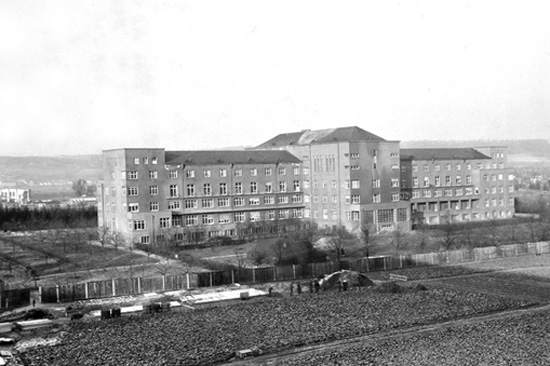
View of “Männerkrankenhaus” (Hospital for Men), Regensburg, Bavaria, Germany. Photo taken in December 1945.
All admissions to the 250th were handled through the A and D office. During the period 1 July 1945 – 31 December 1945, following numbers of cases were admitted to the Hospital: five thousand three hundred twenty (5320) patients, of which three (3) died in the Hospital; one hundred ninety five (195) were transferred to other hospitals; five hundred fifty five (555) were evacuated to the Zone of Interior, and four thousand eighty two (4082) were returned to duty. The Outpatient Clinic functioned well and handled five thousand five hundred sixty four (5564) patients. When the 7th Medical Laboratory closed down on 7 July 1945, all of the laboratory work for the entire Third United States Army Area, was divided between the 250th Station Hospital and the 116th General Hospital.
At the close of 1945, the only important attached unit was the Third Platoon, 41st Field Hospital. The latter had replaced a Platoon of the 65th Field Hospital, which in turn had relieved a Platoon of the 58th Field Hospital, and operated in a castle situated approximately 1½ miles from the Hospital complex proper as an annex for the treatment of syphilis and complicated gonorrhea cases exclusively.
During 1945 and 1946, the 250th Station Hospital was successively under the command of:
Lieutenant Colonel Albert C. Engelbach, MC
Colonel Allan W. Bracher, MC
Colonel Robert W. Boal, MC
Note:
While in Regensburg, Germany, the 250th Sta Hosp was assigned to run the “Männerkrankenhaus” (Hospital for Men –ed) and the “Frauenkrankenhaus” (Hospital for Women –ed), two modern hospital plants built in 1927 and 1929 respectively, and operated by the “Barmherzigen Brüder” until the war changed it all. The “Männerkrankenhaus” was taken over and now operated as a German Army Surgical Hospital. The two plants at takeover by Third United States Army personnel were very well equipped, undamaged by war, and contained facilities for two complete hospitals. They were located on Prüfeningerstraße, about one and a half miles from the center of Regensburg on the Danube in the heart of Bavaria, Germany. After operating as 750-bed Station Hospital for about a year (1945), the bed capacity was reduced to 150. Only the “Männerkrankenhaus” was then being used with the other building being returned to the Germans for civilian use late 1945, or early 1946. Later on (1947) in a effort to conserve manpower, all medical units within the city of Regensburg moved into the Hospital, which was under the command of Major Arthur T. Jones, also Post Commander for Regensburg covering the area between Munich and Nürnberg along the Danube River.
The authors are still looking for additional information relating to the 250th Station Hospital’s last days in Germany. Some pictures courtesy of Donald L. Boatright (son-in-law of 1st Lieutenant Margaret M. Eggert, ANC, N-731929). Any additional data and pictures of subject Hospital would be most welcome. Thank you.
